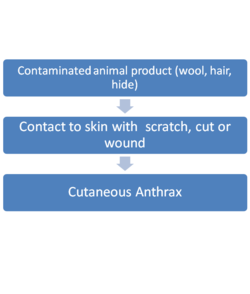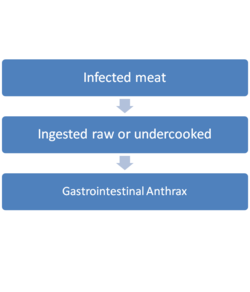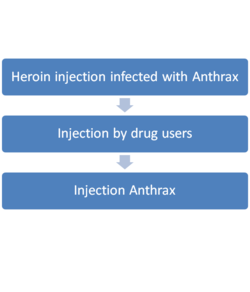Anthrax: Difference between revisions
No edit summary |
No edit summary |
||
| Line 7: | Line 7: | ||
== Definition == | == Definition == | ||
Anthrax is an acute | Anthrax is an acute [[Zoonotic Diseases|zoonotic disease]] caused by the spore-forming bacterium ''Bacillus anthraci''s, a microbe that lives in the soil.<ref>U.S. National Library of Medicine. National Institute of Health. Medline Plus. Anthrax.[https://www.nlm.nih.gov/medlineplus/anthrax.html http://www.nlm.nih.gov/medlineplus/anthrax.html] (accessed 2 March 2011)</ref> | ||
* A serious infectious disease caused by gram-positive, rod-shaped bacteria known as Bacillus anthracis.<ref name=":0">CDC- Anthrax- Basic Information. Available at https://www.cdc.gov/anthrax/basics/index.html (Accessed March 30, 2020) </ref> | * A serious infectious disease caused by gram-positive, rod-shaped bacteria known as ''Bacillus anthracis''.<ref name=":0">CDC- Anthrax- Basic Information. Available at https://www.cdc.gov/anthrax/basics/index.html (Accessed March 30, 2020) </ref> | ||
* Anthrax can be found naturally in soil and commonly affects domestic and wild animals around the world.<ref name=":0" /> | * Anthrax can be found naturally in soil and commonly affects domestic and wild animals around the world.<ref name=":0" /> | ||
* Rare in the United States - people can get sick with anthrax if they come in contact with infected animals or contaminated animal products.<ref name=":0" /> | * Rare in the United States - people can get sick with anthrax if they come in contact with infected animals or contaminated animal products.<ref name=":0" /> | ||
| Line 17: | Line 17: | ||
== Clinically Relevant Anatomy == | == Clinically Relevant Anatomy == | ||
Anthrax can affect different body systems, depending on the route of infection. It can affect the [[Integumentary System|integumentary system]], gastrointestinal/ digestive system and [[Respiratory System|respiratory system]].<br> | |||
== Etiology == | == Etiology == | ||
| Line 37: | Line 37: | ||
== Clinical Presentation == | == Clinical Presentation == | ||
Cutaneous Anthrax | |||
Gastrointestinal Anthrax | |||
Inhalation Anthrax | |||
Injection Anthrax<br> | |||
== Diagnostic Procedures == | == Diagnostic Procedures == | ||
<br> | |||
== Outcome Measures == | |||
== Management / Interventions == | == Management / Interventions == | ||
<br> | |||
== Differential Diagnosis == | == Differential Diagnosis == | ||
<br> | |||
== Resources == | |||
== References == | == References == | ||
<references /> | <references /> | ||
Revision as of 05:22, 31 March 2020
This article or area is currently under construction and may only be partially complete. Please come back soon to see the finished work! (31/03/2020)
Definition[edit | edit source]
Anthrax is an acute zoonotic disease caused by the spore-forming bacterium Bacillus anthracis, a microbe that lives in the soil.[1]
- A serious infectious disease caused by gram-positive, rod-shaped bacteria known as Bacillus anthracis.[2]
- Anthrax can be found naturally in soil and commonly affects domestic and wild animals around the world.[2]
- Rare in the United States - people can get sick with anthrax if they come in contact with infected animals or contaminated animal products.[2]
- Contact with anthrax can cause severe illness in both humans and animals.[2]
- Anthrax is not contagious, which means you can’t catch it like the cold or flu.[2]
- Anthrax can occur in four forms: cutaneous, inhalation, gastrointestinal, and inhalation.[2]
Clinically Relevant Anatomy[edit | edit source]
Anthrax can affect different body systems, depending on the route of infection. It can affect the integumentary system, gastrointestinal/ digestive system and respiratory system.
Etiology[edit | edit source]
The pathogen that causes Anthrax is a bacterium known as Bacillus anthracis.
Epidemiology[edit | edit source]
Pathophysiology[edit | edit source]
Anthrax can occur in four different forms, depending on the route of infection.

|

|

|

|
Clinical Presentation[edit | edit source]
Cutaneous Anthrax
Gastrointestinal Anthrax
Inhalation Anthrax
Injection Anthrax
Diagnostic Procedures[edit | edit source]
Outcome Measures[edit | edit source]
Management / Interventions[edit | edit source]
Differential Diagnosis[edit | edit source]
Resources[edit | edit source]
References[edit | edit source]
- ↑ U.S. National Library of Medicine. National Institute of Health. Medline Plus. Anthrax.http://www.nlm.nih.gov/medlineplus/anthrax.html (accessed 2 March 2011)
- ↑ 2.0 2.1 2.2 2.3 2.4 2.5 CDC- Anthrax- Basic Information. Available at https://www.cdc.gov/anthrax/basics/index.html (Accessed March 30, 2020)






